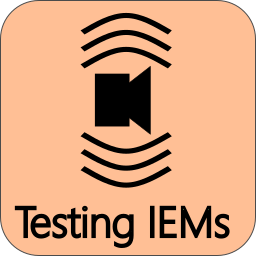
Automated Testing of In-Ear Monitors
Share
The next few months will reveal another round of accessory products for the QA401. Next up is a tester for In Ear Monitors (IEMs) called the QA490. With this product, you can make fast, automated tests for your IEM products. The tests include sensitivity, impedance, crosstalk, polarity, impedance, and the standard tests such as distortion.
The front panel outline of the QA490 is shown below:

The block diagram of the box is shown below. The Inputs are the signal from the QA401. These are AC coupled, and flow into an OPA1622 with 0 or 12 dB of gain. For headphones with impedances below 100 ohms or so, the 0 dB setting makes sense. For headphones with impedances above 100 ohms, the 12 dB setting will allow you to generate enough drive to hit the headphones with the power levels you will need to test. Internally, the QA490 has isolated and split 7V rails, enabling drive levels up to 12.6Vpp = 4.5Vrms. This allows you drive even 600 ohm headphones with 25-30 mW of drive power.
Incorporated with the gain stages are current sense resistors and amplifiers. The current sense resistors are only switched in during impedance measurements, ensuring the output impedance of the amp stage isn't compromised by the current sense resistors.
The amplified signal is then presented to the front-panel via a 1/4" TRS connector. Your Device Under Test (DUT) headphones can be plugged into that connector and then placed into the front-panel ear cups.
The front-panel ear cups are 3D printed via selectively laser-sintered techniques. While the stock cups will work with most IEMs and the standard silicone tips, we can easily modify the front-panel cups to support whatever hardware you might want to connect.
The ear cups are acoustically coupled to MEMS mics mounted on the main PCB via a 13 mm long and 3 mm diameter acoustic path that an integral part of the 3D assembly.

MEMS mics on the main PCB were selected for their matching, with +/- 1 dB guaranteed by the vendor.
Repeatability is very good. We'll share more data on that in the coming month as the product is finalized for sale. But the setup overall is relatively insensitive to operator insertion. The ear cups were design to ensure a self-centering via tapering and a consistent bottoming out.
Note the QA490 is designed to compare a DUT to a golden reference. While the frequency response of the QA490 extends beyond 20 kHz, the region for testing is expected to be around 100 Hz to 10 kHz. Beyond those limits there are resonances that make the operator training more critical. But generally a headphone that is exhibiting expected performance within the 100 Hz to 10 kHz region will not exhibit poor performance outside that region.
If you are testing headphones in volume, we'd love to hear from you. Contact us at the Sales alias.

If you liked the post you just read, please consider signing up for our mailing list at the bottom of the page.
You can discuss this post on the forum here.
